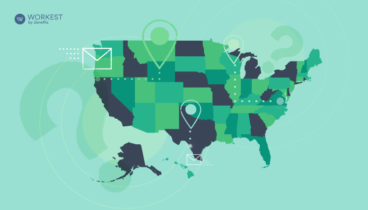What are some workforce trends I should be aware of as I plan for 2023?
Questions are submitted by our Workest readers. Sign up to ask an HR question of your own, and to contribute to the conversation
In today’s increasingly complex world, acting on gut feelings is not always the best way to make company decisions, especially when it involves your people.
Andrea Derler, Principal of Research and Value at Visier, shares what workforce trends leaders should be aware of and the analytics they should track alongside them.
1. Talent, attraction, and retention
Not even half of all leaders we surveyed were very confident in their ability to attract talent and retain talent. One of the questions they sometimes missed asking themselves is, what can I offer new hires apart from pain benefits? The metrics we recommend to track when it comes to attracting and retaining great talent of organizations of all sizes really are what is the demographic of applicants who turn into interviewees turn into hires. What are our typical hiring sources? Are we always going to the same places? Are we always having the same conversations with a very similar population or have our hiring choices brought us great talent? We can track that by looking at the performance of new hires 6, 12, 18 months down the line.
The 2nd metric that you can track is around the time to hire. When you are thinking about your application hiring process for new hires, how long does it actually take your organization to hire people from start to finish? Can that process be done more effectively?
The 3rd one is about retention. Once you’ve got the talent in the door, the biggest concern for many organizations is retaining that talent. One way to track that is to look at your voluntary turnover, specifically, at resignation rates. You wanna know and track who is leaving and why.
1. Diversity, equity and inclusion
There are 3 things that important to know when it comes to this topic. First of all, there is a lot of data and research out there that confirms that more diverse teams are simply more beneficial for organizations. They perform higher. They are more creative. And we learned recently that different generations have different expectations. For example, younger generations expect employers to be very transparent regarding pay. Next, you have to know that all humans and humans are biased. Bias is part of our human conditioning. So mitigating bias is really important across the talent cycle from hiring to separations. So what metrics should you track? The 1st one is you should be looking at what’s the diversity of your current workforce? For example, genders in the people of different ethnicities. How open are you towards unusual talent backgrounds?
The 2nd metric to track is diversity across the hiring funnel and promotions. You should be asking yourself, are women and minorities represented when it comes to hiring processes or promotions?
And the 3rd metric is how much are you doing in your organization to mitigate bias in hiring and promotion decisions? One way to look at that is at which stage of the hiring process do you really lose diverse candidates? Are they usually dropping out during the interview? Then you could be asking yourselves, are we doing enough structured interviews asking the same questions to every candidate? Or do you take the names off of resumes before you even look at them?
2. Leaders’ mindset around data
How much data do leaders and managers use for the decision-making processes? We’ve found that leaders sometimes think they have enough data to make the right decisions. But when we look a little closer at how confident they are to tackle and manage certain talent problems, so challenges. It turns out they have a really hard time understanding how they can actually attract great talent for their teams, how they can keep people on the team in the organization, or how they conduct workforce planning when the organization changes substantially.
Metrics you can track and questions you could ask yourself as a leader about that topic would be how many of the managers and leaders in my organizations have access to data? People and businesses use it regularly. The second question you can ask is which decisions are being made or not made based on data? For example, are we looking at data when we are doing workforce planning for business expansion? Are we looking at data? When we look at hiring decisions, diversity, equity, inclusion-related decisions for promotions, are we really utilizing the actual metrics that we tracked over years over the month? Or are we still relying to some degree on gut feeling and experience? And the last metric you could always track is how are we compared to other organizations?
For more in-depth knowledge about these analytics, you can check out the video below.
What do you think? Join The Conversation
Please login or Register to submit your answer
This website provides general information related to Zenefits services and related laws and best practices. This content and Zenefits employees do not provide legal advice. While we strive to provide useful general information applicable to the majority of our readers, we do not - and cannot - provide legal advice specific to your company and your situation. Already a Zenefits customer? Enjoy on-demand HR Advisory Services for all your HR and compliance questions. If not, learn more here.




